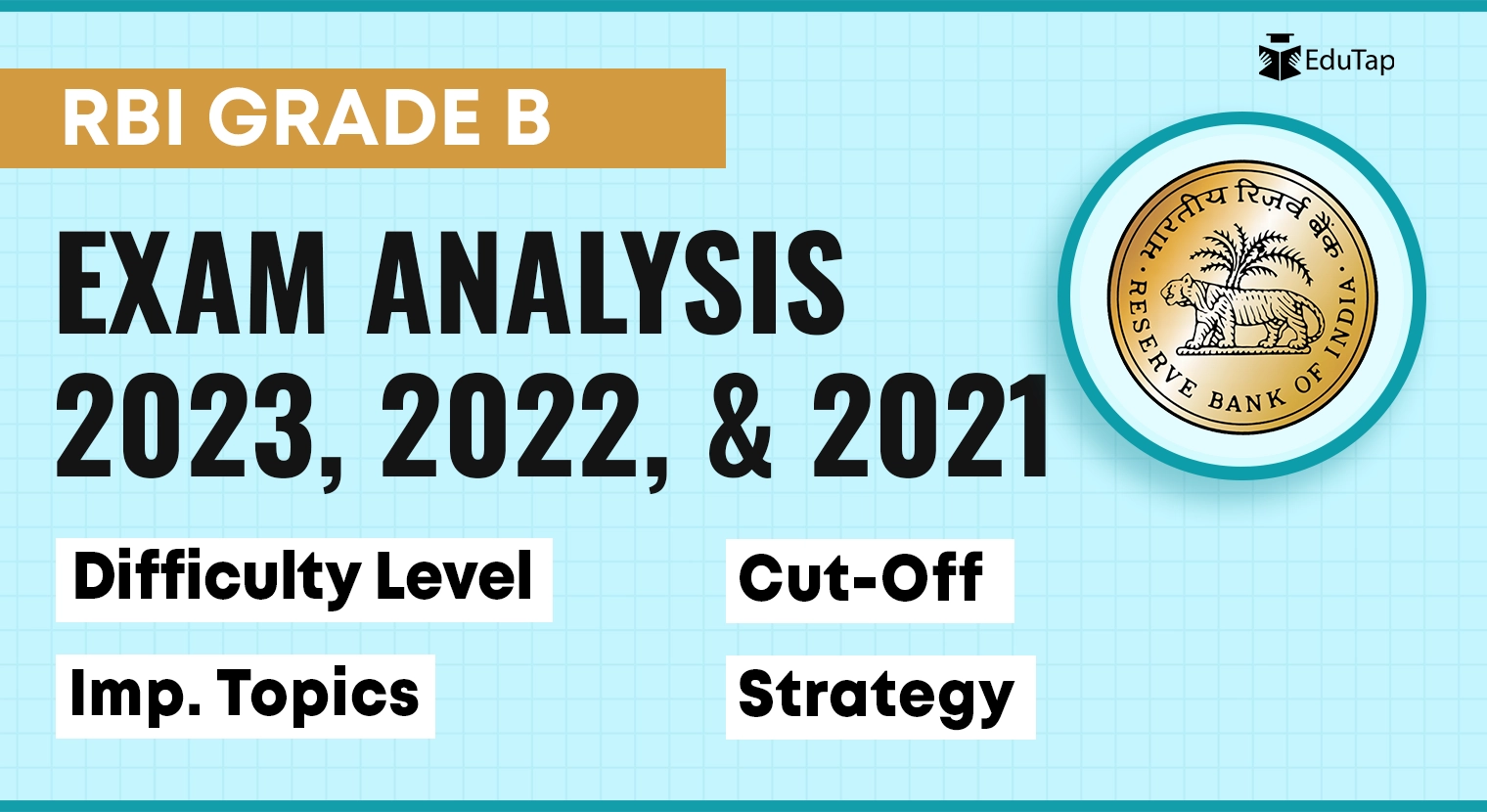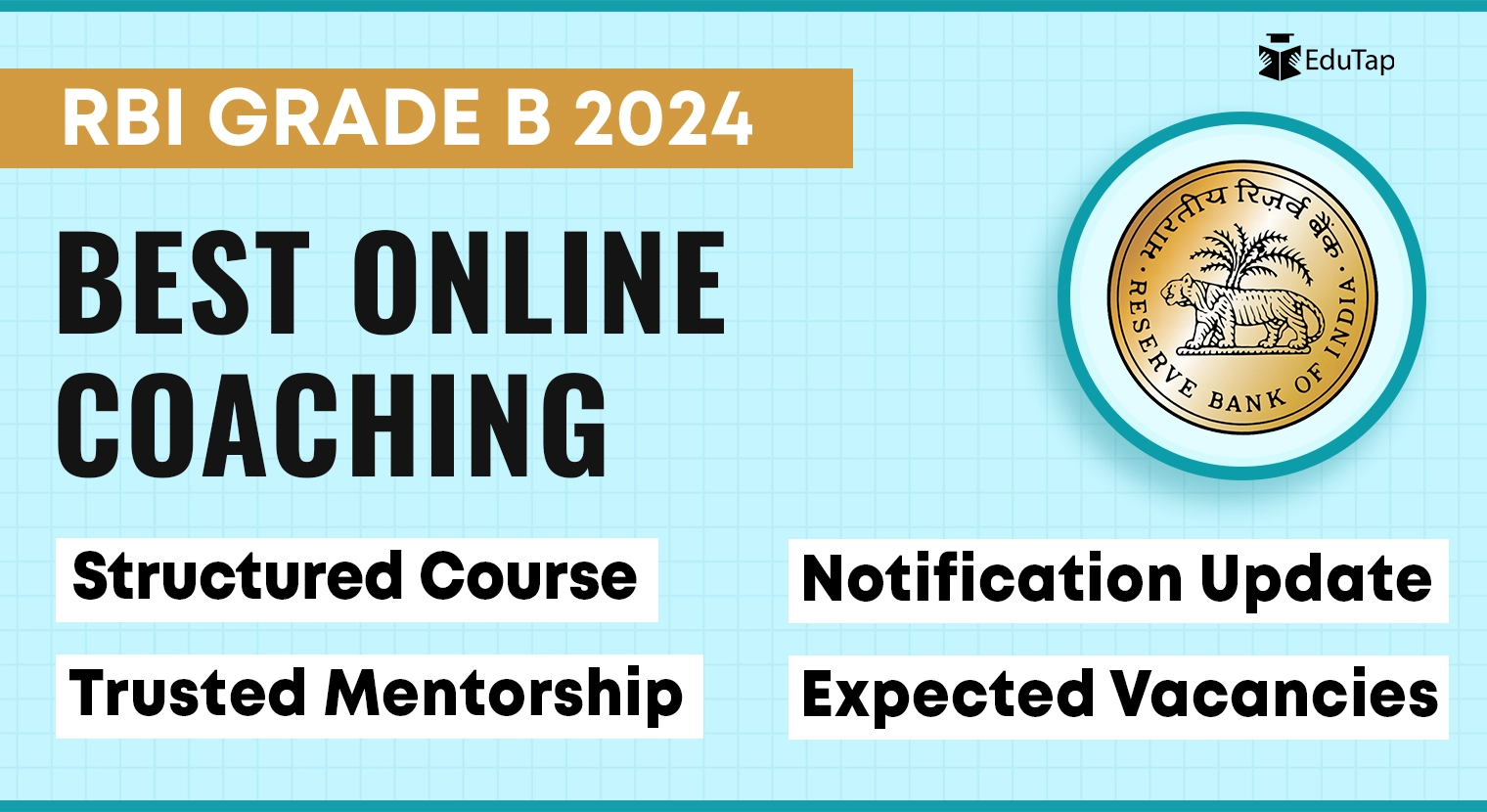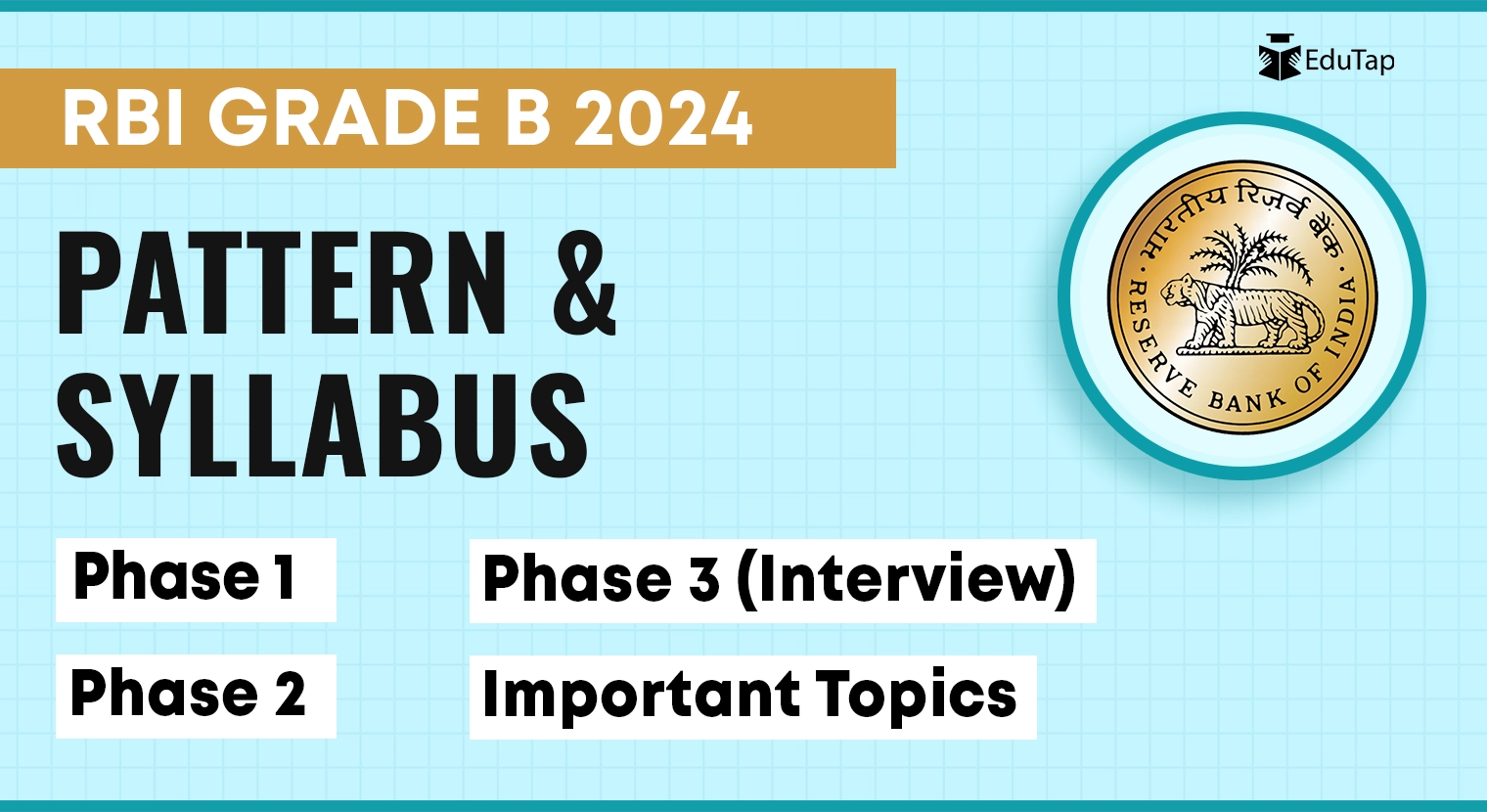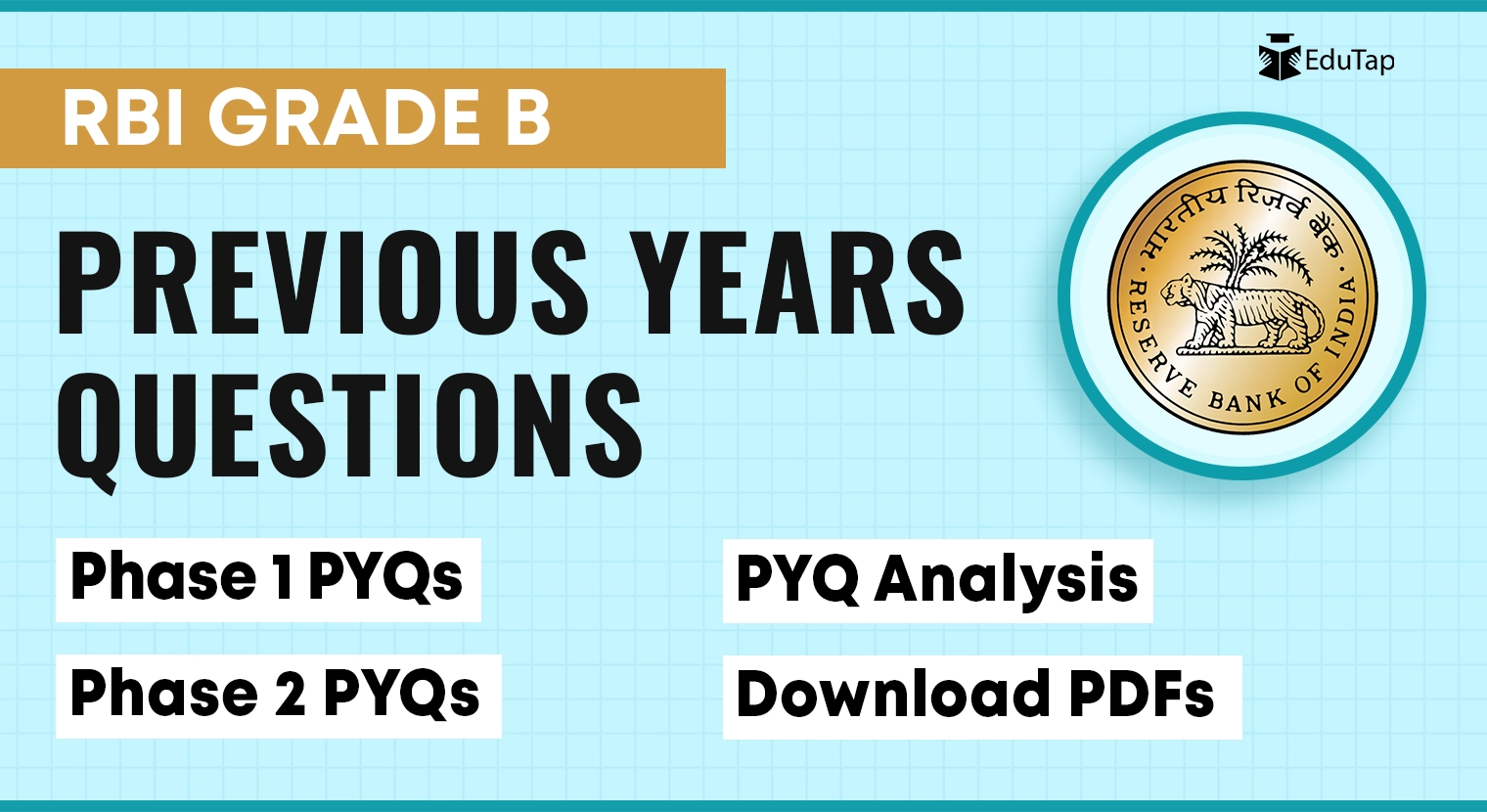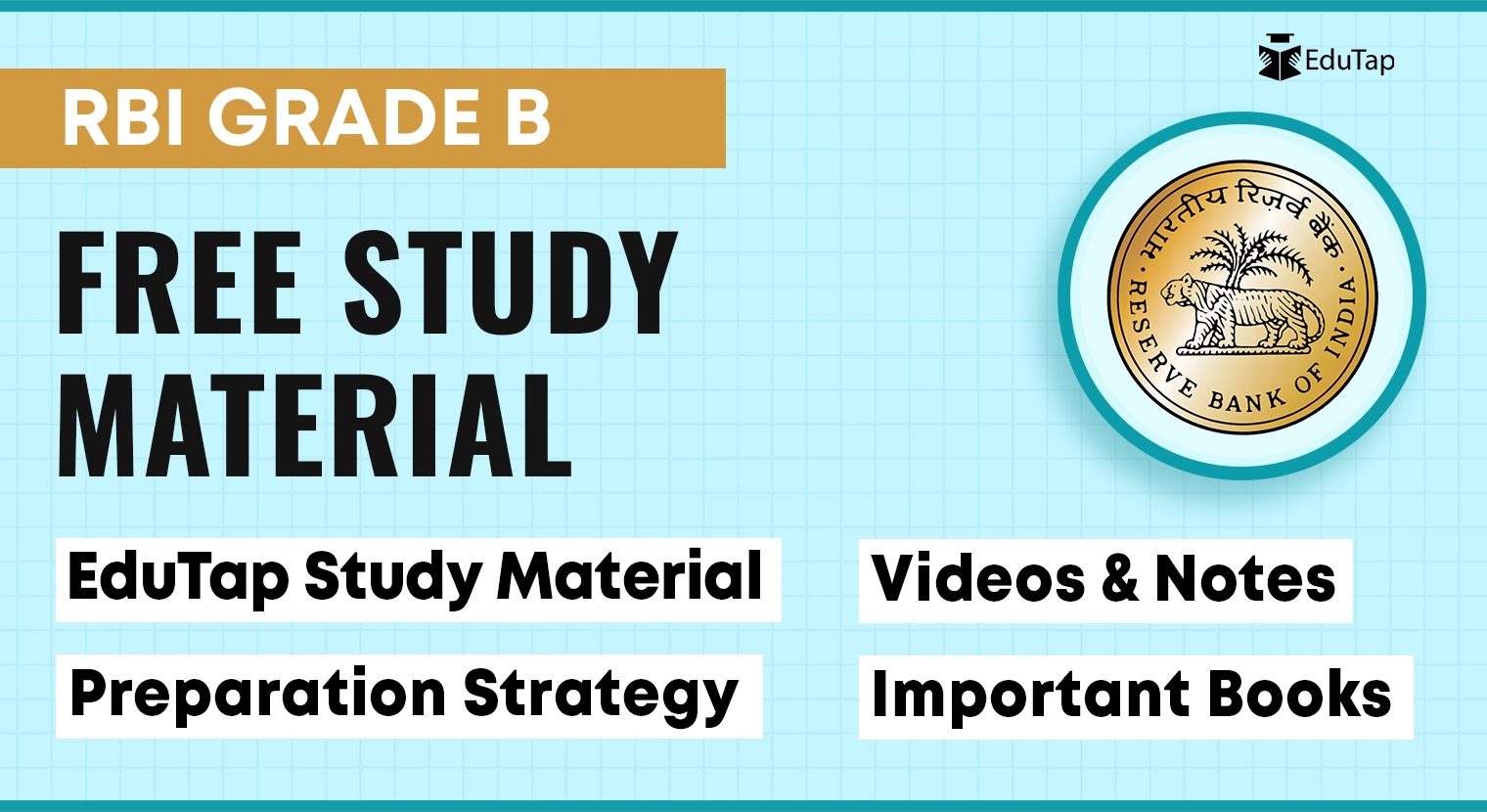RBI Grade B Exam analysis serves as a crucial tool that empowers candidates with the knowledge needed to enhance their preparation and increase the likelihood of success in the examination.
In this article, we’ll provide a complete RBI Grade B exam analysis, offering valuable insights into various aspects, including cut-off marks, difficulty levels, and topic weightage. This analysis will offer you a detailed understanding of the exam trends and help you tailor your preparation accordingly.
RBI Grade B Exam Analysis: Cut-Off Marks
Below, we have mentioned the RBI Grade B cut-off marks from 2018 to 2023.
| Cut-Off Marks | |||||
| Phases | 2023* | 2022* | 2021-20 | 2019 | 2018 |
| General | |||||
| Phase 1 | 54.25 | 63.75 | 66.75 | 122 | 105.75 |
| Phase 2 | – | 171.25 | 187.75 | 193.25 | 201.25 |
| Final | – | 234.50 | 252.25 | 238.25 | 248.50 |
| EWS | |||||
| Phase 1 | 54.25 | 63.75 | 66.75 | 122 | – |
| Phase 2 | – | 171.25 | 187.75 | 193.25 | – |
| Final | – | 187.50 | 241.25 | 197.00 | – |
| OBC | |||||
| Phase 1 | 54.25 | 60.25 | 63.75 | 115.50 | 95.75 |
| Phase 2 | – | 167.00 | 167.50 | 188.00 | 186.25 |
| Final | – | 223.00 | 212.25 | 215.50 | 235.50 |
| SC | |||||
| Phase 1 | 52.75 | 55.25 | 53.50 | 108 | 91.75 |
| Phase 2 | – | 150.50 | 166.75 | 172.25 | 180.25 |
| Final | – | 202.50 | 205.25 | 206.50 | 221.25 |
| ST | |||||
| Phase 1 | 44.75 | 50.75 | 52.75 | 108 | 91.75 |
| Phase 2 | – | 150.25 | 187.75 | 172.25 | 180.25 |
| Final | – | 179.00 | 218.25 | 194.00 | 219.50 |
| PwBD (OH/HI/VH/MD) | |||||
| Phase 1 | 40.25 | 49.75 | 52.75 | 108 | 91.75 |
| Phase 2 | – | 150.25 | 166.75 (HI, LD, MD) 169.75(VI) | 172.25 (HI, LD, MD) 176.75 (VI) | 180.25 |
| Final | – | 208.25 (Gen) 196.75 (OBC) 176.25 (SC) EWS & ST in PwBD not qualified | Gen 226 OBC 223.75 | Gen 215.75 OBC 194.75 | Gen 235.50 OBC 223.00 |
*Please Note: From 2021-20 onwards, the total marks for Phase 2 and the Interview have been revised to 375, whereas, before that, they were 350.
Detailed RBI Grade B Exam Cut-Off Analysis
The cut-off marks for the RBI Grade B exam reveal a dynamic trend over the specified years. Starting from 2019, there have been significant changes in the cut-offs for various categories. Below, we have explained the trend of cut-offs using general category data.
RBI Grade B Phase 1 Cut-Off Analysis
The Phase 1 cut-off exhibited a notable shift, rising from 105.75 in 2018 to 122 in 2019 and declining to 66.75, 63.75, and 54.25 in 2021-20, 2022, and 2023, respectively.
RBI Grade B Phase 2 Cut-Off Analysis
The Phase 2 cut-offs displayed a constant downward trajectory, with scores decreasing from 201.25 in 2018 to 193.25, 187.75, and 171.25 in 2019, 2020, and 2022, respectively. This shift can be attributed to various factors, including changes in the total marks for Phase 2 and the Interview, which were revised from 350 to 375 starting in 2020.
RBI Grade B Final Cut-Off Analysis
The final cut-off marks have changed over the years, showcasing a fluctuating trend. In 2019, the cut-off decreased to 238.25, which was 248.50 in 2018. Notably, the cut-off increased to 252.25 in 2021-20 but experienced a decline to 234.50 in 2022.
Aspirants should consider these trends while preparing and adapting their strategies to the changing dynamics of the RBI Grade B examination.
Key Takeaways
- RBI Grade B cut-offs are dynamic and influenced by various factors such as the difficulty level, the number of vacancies, and the overall performance of candidates.
- In 2022 and 2021-20, the overall cut-off is 63% and 65% respectively. The elevated cut-off marks suggest that the exam difficulty level ranges from easy to moderate.
- With a 63-mark difference between the 2022 Phase 2 and Final cut-offs, it becomes evident that merely clearing the cut-off is insufficient. Scoring higher in Phase 2 helps alleviate the pressure during the Interview stage.
Now that you have understood the overall cut-off marks, let’s understand the sectional cut-offs of the RBI Grade B Phase 1.
RBI Grade B Phase 1 Sectional Cut-Off Marks
Here are the Phase 1 sectional cut-off marks of the RBI Grade B exam.
| RBI Grade B Phase 1 Sectional Cut-Off Marks (General) | |||||
| Phase 1 | 2023 | 2022 | 2021-20 | 2019 | 2018 |
| GA (80) | 12 | 12 | 16 | 20 | 20 |
| Reasoning (60) | 4.5 | 4.5 | 6 | 7.5 | 7.5 |
| English (30) | 4.5 | 4.5 | 6 | 7.5 | 7.5 |
| Quant (30) | 9 | 9 | 12 | 15 | 15 |
| Total (200) | 54.25 | 63.75 | 66.75 | 122 | 105 |
Key Takeaways
The sectional cut-off marks are 25% in 2018 and 2019, 20% in 2020-21, and 15% in 2022 and 2023. To explain it further, let’s take an example of the 2023 General Awareness cut-off. Total GA marks are 80 and the cut-off is 12, which is 15% of 80 and it applies to all the subjects.
Important Note: In addition to clearing individual subject cut-offs, it’s crucial to meet the overall cut-off for Phase 1.
After getting familiar with the RBI Grade B exam cut-offs, let’s understand its difficulty level over the years.
Difficulty Level of RBI Grade B Phase 1 and 2
Below, we have mentioned the subject-wise difficulty level of the RBI Grade B Phase 1 and Phase 2.
Reasoning Difficulty Level
The table below contains the year-wise distribution of easy, moderate, and difficult questions out of the total number of reasoning questions from 2021 to 2023.
| Reasoning Difficulty Level | ||||
| 2023 | 2022 | 2021 | ||
| Total Questions | 60 | 60 | 60 | |
| Difficulty Level | Easy | 6 | 5 | 5 |
| Moderate | 27 | 15 | 10 | |
| Difficult | 27 | 40 | 45 | |
Overall Reasoning Difficulty Level
- 2023: Moderate to Difficult
- 2022: Moderate to Difficult
- 2021: Moderate to Difficult
Key Takeaway
Each year, the RBI Grade B reasoning section has a mix of easy, moderate, and difficult questions, with a prevailing trend towards moderate to difficult ones. However, it is important to note that in 2023, the reasoning cut-off is just 9 marks out of 60, making it crucial to practise moderate-level questions, especially if the reasoning is not your strong suit, to clear the subject cut-off.
Quantitative Aptitude Difficulty Level
The table below contains the year-wise distribution of easy, moderate, and difficult questions out of the total number of quant questions from 2021 to 2023.
| Quantitative Aptitude Difficulty Level | ||||
| 2023 | 2022 | 2021 | ||
| Total Questions | 30 | 30 | 30 | |
| Difficulty Level | Easy | 1 | 2 | 03 |
| Moderate | 2 | 13 | 04 | |
| Difficult | 21 | 15 | 23 | |
Overall Quantitative Aptitude Difficulty Level
- 2023: Difficult
- 2022: Moderate to Difficult
- 2021: Difficult
Key Takeaway
Over the years, a consistent pattern emerges, indicating a tendency towards difficulty, particularly in the quantitative section. However, it is important to note that in 2023, the quant cut-off is 4.5 marks out of 30. While the overall difficulty level may be high, achieving the set cut-off is achievable with practice.
General Awareness (GA) Difficulty Level
The table below contains the year-wise distribution of easy, moderate, and difficult questions out of the total number of GA questions from 2021 to 2023.
| GA Difficulty Level | ||||
| 2023 | 2022 | 2021 | ||
| Total Questions | 80 | 80 | 80 | |
| Difficulty Level | Easy | 15 | 28 | 30 |
| Moderate | 40 | 35 | 31 | |
| Difficult | 25 | 17 | 19 | |
Overall GA Difficulty Level
- 2023: Moderate
- 2022: Easy to Moderate
- 2021: Easy to Moderate
Key Takeaway
Over the years, the distribution between easy, moderate, and difficult levels of GA remains relatively stable. With the sectional cut-off of 12 marks out of 80, candidates can easily achieve this by maintaining a balanced focus on easy and moderately challenging questions.
English Difficulty Level
The table below contains the year-wise distribution of easy, moderate, and difficult questions out of the total number of English questions from 2021 to 2023.
| English Difficulty Level | ||
| SNo. | Year | Difficulty Level |
| 1 | 2023 | Easy to Moderate |
| 2 | 2022 | Moderate to Difficult |
| 3 | 2021 | Moderate to Difficult |
Overall English Difficulty Level
The overall English difficulty level is Moderate to Difficult.
Key Takeaway
These key takeaways highlight the varied difficulty levels in the English section over the years. Notably, the cut-off was merely 4.5 out of 30 marks in 2023, emphasising that candidates can effortlessly meet and exceed this cut-off threshold with a well-crafted preparation strategy.
Important Note:
Candidates can easily clear the sectional cut-off of individual subjects. However, they also need to clear the overall cut-off of Phase 1 which was 54.25 for the general category in 2023.
Understanding the cut-offs for individual subjects allows students to tailor their exam preparation based on their strengths and weaknesses. For example, students can focus on meeting the cut-off for a particular subject where they face difficulties and leverage their strong subjects, to surpass the overall cut-off for the RBI Grade B Phase 1 exam.
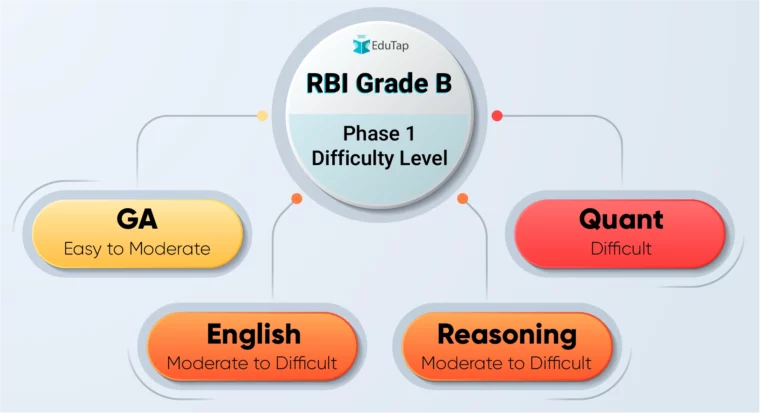
After getting familiar with the RBI Grade B Phase 1 difficulty level, let’s take a look at the difficulty level of Phase 2.
Finance and Management (Objective) Difficulty Level
The table below contains the year-wise distribution of easy, moderate, and difficult questions out of the total number of objective finance and management questions from 2021 to 2023.
| Finance and Management Difficulty Level (Objective) | ||||
| 2023 | 2022 | 2021 | ||
| Total Questions | 30 | 30 | 30 | |
| Difficulty Level | Easy | 25 | 16 | 23 |
| Moderate | 5 | 11 | 6 | |
| Difficult | 0 | 3 | 1 | |
Overall Finance and Management Objective Difficulty Level
- 2023: Easy
- 2022: Easy to Moderate
- 2021: Easy
Key Takeaway
The objective Finance and Management section has shown a consistent trend, featuring many easy questions in recent years. Candidates should leverage this pattern to streamline their preparation by mastering fundamental concepts.
Finance and Management (Descriptive) Difficulty Level
The table below contains the year-wise distribution of easy, moderate, and difficult questions out of the total number of descriptive finance and management questions from 2021 to 2023.
| Finance and Management Difficulty Level (Descriptive) | ||||
| 2023 | 2022 | 2021 | ||
| Total Questions | 6 | 6 | 6 | |
| Difficulty Level | Easy | 1 | 2 | 5 |
| Moderate | 5 | 4 | 1 | |
| Difficult | 0 | 0 | 0 | |
Overall Finance and Management Descriptive Difficulty Level
- 2023: Easy to Moderate
- 2022: Easy to Moderate
- 2021: Easy
Key Takeaway
The subjective Finance and Management section reflects a consistent pattern of easy to moderate-level questions. This data shows a manageable difficulty level, underscoring the need for adaptive preparation.
Descriptive English Difficulty Level
The table below contains the year-wise distribution of easy, moderate, and difficult questions out of the total number of English essay questions from 2021 to 2023.
| English Essay Difficulty Level | ||||
| 2023 | 2022 | 2021 | ||
| Total Questions | 4 | 4 | 4 | |
| Difficulty Level | Easy | 1 | 1 | 1 |
| Moderate | 2 | 2 | 2 | |
| Difficult | 1 | 1 | 1 | |
Overall Descriptive English Difficulty Level
- 2023: Moderate
- 2022: Moderate
- 2021: Moderate
- 2019: Easy to Moderate
Key Takeaway
The overall difficulty level in the English Essay section exhibits a consistent pattern over the years. This consistency implies that candidates can anticipate a well-rounded mix of difficulty levels in the English Essay section over the years.
Economic and Social Issues (Objective) Difficulty Level
The table below contains the year-wise distribution of easy, moderate, and difficult questions out of the total number of objective economic and social issues questions from 2021 to 2023.
| Economic and Social Issues Difficulty Level Phase 2 (Objective) | ||||
| 2023 | 2022 | 2021 | ||
| Total Questions | 30 | 30 | 30 | |
| Difficulty Level | Easy | 6 | 9 | 9 |
| Moderate | 18 | 14 | 12 | |
| Difficult | 6 | 7 | 9 | |
Overall Economic and Social Issues Objective Difficulty Level
The overall Economic and Social Issues objective difficulty level is Moderate.
- 2023: Moderate
- 2022: Moderate
- 2021: Moderate
Key Takeaway
The overall difficulty level of the ESI objective presents a balanced distribution across difficulty levels with a predominant focus on moderate questions. To excel, aspirants should ensure comprehensive preparation across all difficulty levels.
Economic and Social Issues (Descriptive) Difficulty Level
The table below contains the year-wise distribution of easy, moderate, and difficult questions out of the total number of descriptive economic and social issues questions from 2021 to 2023.
| Economic and Social Issues Difficulty Level (Descriptive) | ||||
| 2023 | 2022 | 2021 | ||
| Total Questions | 6 | 6 | 6 | |
| Difficulty Level | Easy | 3 | 2 | 2 |
| Moderate | 0 | 2 | 2 | |
| Difficult | 3 | 2 | 2 | |
Overall Economic and Social Issues Descriptive Difficulty Level
- 2023: Moderate
- 2022: Moderate
- 2021: Moderate
Key Takeaway
The overall difficulty level of ESI subjective is moderate. Candidates should tailor their preparation by focusing on understanding key concepts, staying updated on relevant issues, and practising descriptive writing to navigate this section effectively.
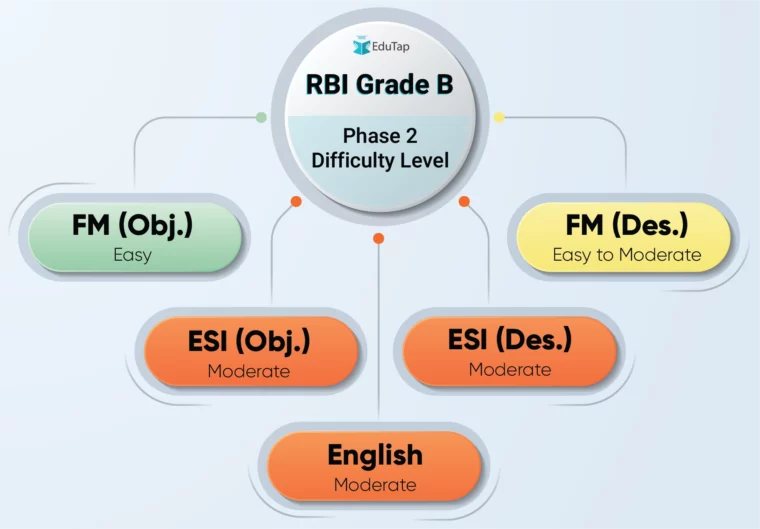
After understanding the difficulty level of the RBI Grade B exam, let’s find out how the difficulty level changes over the years.
How Difficulty Level Changes Over the Years
The difficulty level of the RBI Grade B exam has increased over the years. To explain this further, let’s take an example of General Awareness, which has seen lots of changes.
1. In-Depth Questions
Before 2021-20, RBI asked direct questions related to News, schemes, reports, current affairs, etc. E.g., Nand Mulchandani has been appointed as Chief Technology Officer of_________.
Now, from 2021-20 onwards, the difficulty level has escalated, and there are hardly any direct questions; questions are presented in detail. E.g., Nand Mulchandani, recently appointed as the Chief Technology Officer of the Central Intelligence Agency, previously served as the Acting Director in which organisation?
Important Note
Candidates need to focus on conceptual understanding. This approach will enable you to answer questions even when the format deviates from direct queries.
2. Statement-Based Questions
The trend of statement-based questions has been consistently on the rise since the year 2021-20 onwards. This indicates a shift in the question pattern where candidates are required to derive answers or conclusions based on provided statements rather than relying on straightforward queries. Such questions often demand a deeper understanding of the subject and the ability to analyse and interpret information effectively. E.g.,
Paragraph: Indian Government is committed to providing financial inclusiveness and support to the marginalised and hitherto socio-economically neglected classes. Financial Inclusion is a national priority of the Government as it is an enabler for inclusive growth. It is important as it provides an avenue for the poor to bring their savings into the formal financial system, an avenue to remit money to their families in villages besides taking them out of the clutches of the usurious money lenders.
In the same regard, one such _______”X” _____ scheme to promote financial inclusion, was
launched by the government on 15th August 2014, which is one of the biggest financial inclusion initiatives in the world.
Moving forward, to move towards creating a universal social security system for all Indians, especially the poor and the underprivileged, three ambitious Jan Suraksha Schemes or Social Security Schemes about the Insurance and Pension Sector were announced by the Government in the Budget for 2015-16. The schemes were launched on 9th May 2015, to provide life & accident risk insurance and social security at a very affordable cost namely (a) Pradhan Mantri Suraksha Bima Yojana (b) Pradhan Mantri Jeevan Jyoti Yojana and (C) Atal Pension Yojana
(This is a recreated passage and not the exact one asked in the exam)
Question: Read the above passage carefully, and identify the “____X____” scheme launched by the government on 15th August 2014. (2 Marks)
- Pradhan Mantri Jeevan Kalyan Yojana
- Pradhan Mantri Jan Dhan Yojana
- Pradhan Mantri Jan Arogya Yojana
- Pradhan Mantri Jan Manthan Yojana
- Pradhan Mantri Jan Yojana
Important Note
Candidates should focus on developing strong analytical and interpretative skills to excel in this evolving question format.
3. Less Time
In the General Awareness section, candidates are required to solve 80 questions within a time constraint of 25 minutes. The introduction of statement-based questions in this section poses a unique challenge.
Unlike traditional questions, statement-based questions demand more time for comprehension and understanding due to their complex nature. Candidates are not only required to read the questions but also to analyse and interpret the provided statements accurately to get the correct answer.
Important Note
This shift in question format emphasises the importance of time management. Candidates also need to enhance their analytical and interpretative skills to navigate the GA section effectively within the allotted time frame.
After understanding how difficulty level changes over the years, let’s take a look at the subject-wise weightage of the topics.
Subject-Wise Weightage of Topics
In the following sections, we’ve outlined the weightage of the subject-wise topics for the RBI Grade B (Phase 1 and 2) exam. It’s important to note that each question in Phase 1 is assigned a value of 1 mark.
Reasoning Topic Weightage
We have analysed the year-wise trend of the number of questions asked from each topic of reasoning from 2021 to 2023 to identify their weightage.
| Reasoning Topic Weightage | ||||
| Number of Questions/Topic Weightage | ||||
| SNo. | Topics | 2023 | 2022 | 2021 |
| 1 | Seating Arrangement | 14 | 10 | 13 |
| 2 | Puzzle | 15 | 20 | 10 |
| 3 | Analytical Reasoning | 9 | 12 | 12 |
| 4 | Syllogism | 4 | 3 | 2 |
| 5 | Alphanumeric Symbolic Series | 2 | 0 | 0 |
| 6 | Inequality | 2 | 2 | 3 |
| 7 | Input Output | 5 | 5 | 5 |
| 8 | Data Sufficiency | 4 | 5 | 3 |
| 9 | Coding Decoding | 3 | 0 | 3 |
| 10 | Blood Relation | 2 | 3 | 5 |
| 11 | Direction Sense | 0 | 0 | 1 |
| 12 | Ranking & Order | 0 | 0 | 3 |
We have carefully analysed the number of questions asked from each topic of reasoning in the past years to identify the important topics.
Important Reasoning Topics
Based on our analysis, here are the most important reasoning topics:
- Alphabetical, Alphanumeric Series
- Coding & Decoding
- Machine Input Output
- Syllogism
- Direction Sense
- Inequality
- Ranking
- Blood Relation
- Seating Arrangement
- Puzzles
Quantitative Aptitude Topic Weightage
We have analysed the year-wise trend of the number of questions asked from each topic of quant from 2021 to 2023 to identify their weightage.
| Quant Topic Weightage | ||||
| Number of Question/Topic Weightage | ||||
| SNo. | Topics | 2023 | 2022 | 2021 |
| 1 | Data Interpretation | 15 | 14 | 7 |
| 2 | 2D, 3D, & Probability | 1 | 1 | 0 |
| 3 | Quantity Comparison | 3 | 2 | 6 |
| 4 | Ages, Partnership | 1 | 0 | 2 |
| 5 | Time & Distance | 0 | 0 | 0 |
| 6 | Time & Work, Pipes | 0 | 0 | 0 |
| 7 | Alligation Mixture | 0 | 0 | 0 |
| 8 | Simple & Compound Interest | 1 | 2 | 1 |
| 9 | Wrong, Number Series | 3 | 3 | 1 |
| 10 | Profit & Loss | 0 | 0 | 0 |
| 11 | Ratio & Proportion | 0 | 0 | 1 |
| 12 | Data Sufficiency | 0 | 0 | 3 |
| 13 | Percentage | 0 | 0 | 1 |
| 14 | Statement Based Questions | 2 | 2 | 5 |
| 15 | Miscellaneous | 1 | 0 | 3 |
| 16 | Quadratic Equation | 2 | 4 | 0 |
| 17 | Boats & Stream | 1 | 1 | 0 |
We have carefully analysed the number of questions asked from each quant topic in the past years to identify the important questions.
Important Quant Topics
Based on our analysis, here are the most important quantitative topics:
- Number Series
- Percentage
- Profit & Loss
- Quadratic Equation
- Time, Speed, & Distance
- Ratio
- Data Interpretation
General Awareness (GA) Topic Weightage
We have analysed the year-wise trend of the number of questions asked from each topic of general awareness from 2021 to 2023 to identify their weightage.
GA General Topic Weightage
Here is the topic-wise weightage of GA general:
| GA General Topic Weightage | ||||
| Number of Question/Topic Weightage | ||||
| 2023 | 2022 | 2021 | ||
| Total | 80 | 80 | 80 | |
| Type of Questions | Current Affairs | 74 | 66 | 68 |
| Static | 6 | 14 | 12 | |
GA Current Affairs Topic Weightage
Here is the topic-wise weightage of GA current affairs:
| GA Current Affairs Topic Weightage | ||||
| Number of Question/Topic Weightage | ||||
| 2023 | 2022 | 2021 | ||
| Total | 74 | 66 | 68 | |
| Type of Questions | Phase 1 Specific GA | 25 | 30 | 31 |
| Schemes | 8 | 10 | 9 | |
| ESI Current Affairs | 19 | 11 | 13 | |
| Finance/RBI Notification | 14 | 12 | 10 | |
| Reports | 8 | 3 | 5 | |
GA Static Topic Weightage
Here is the topic-wise weightage of GA static:
| GA Static Topic Weightage | ||||
| Number of Question/Topic Weightage | ||||
| 2023 | 2022 | 2021 | ||
| Total | 6 | 14 | 12 | |
| Type of Questions | Finance Static | 4 | 5 | 0 |
| ESI Static | 2 | 3 | 0 | |
| International Organization | 0 | 4 | 0 | |
| Places in News | 0 | 2 | 0 | |
| National Parks | 0 | 0 | 1 | |
| Regional Festivals | 0 | 0 | 1 | |
| Location of lakes/waterfalls | 0 | 0 | 1 | |
| Location of headquarters | 0 | 0 | 1 | |
| Banking Awareness | 0 | 0 | 7 | |
| Miscellaneous | 0 | 0 | 1 | |
| Countries/Capitals/Currencies | 0 | 0 | 0 | |
| Location of Airports | 0 | 0 | 0 | |
| Sports | 0 | 0 | 0 | |
| Defence and Science & Tech. | 0 | 0 | 0 | |
| Personalities in News | 0 | 0 | 0 | |
| Events – International | 0 | 0 | 0 | |
| Events – National | 0 | 0 | 0 | |
We have carefully analysed the number of questions asked from each general awareness topic in the past years to identify the important topics.
Important General Awareness Topics
General awareness questions can be asked from any of the above-mentioned topics. Therefore, it’s essential to regularly follow reputable newspapers, news websites, official government portals, and magazines to stay informed about these current affairs topics.
English Topic Weightage
We have analysed the year-wise trend of the number of questions asked from each topic of English from 2021 to 2023 to identify their weightage.
| English Topic Weightage | ||||
| Number of Questions/Topic Weightage | ||||
| SNo. | Topics | 2023 | 2022 | 2021 |
| 1 | Reading Comprehension | 7 | 6 | 13 |
| 2 | Sentence Correction | 5 | 2 | 4 |
| 3 | Sentence Completion | 0 | 4 | 0 |
| 4 | Fill in the Blanks | 0 | 3 | 0 |
| 5 | Statement Correction | 0 | 2 | 0 |
| 6 | Idiom/Phrases Usage | 0 | 0 | 2 |
| 7 | Word Replacement | 4 | 2 | 0 |
| 8 | Starters | 0 | 0 | 0 |
| 9 | Double Fillers | 0 | 3 | 0 |
| 10 | Sentence Rearrangement | 5 | 4 | 0 |
| 11 | Cloze Test | 0 | 0 | 5 |
| 12 | Sentence Connectors | 0 | 0 | 3 |
| 13 | Error Detection | 5 | 4 | 3 |
| 14 | Word Reshuffle | 4 | 0 | 0 |
We have carefully analysed the number of questions asked from each topic of English in the past years to identify the important questions.
Important English Topics
Based on our analysis, here are the most important English topics:
- Grammar
- Subject-Verb Agreement
- Tenses
- Conditional Sentences
- Preposition
- Complex Preposition
- Conjunction
- Advance Verbs
- Reading Comprehension
- Cloze Test
- Double Fillers
- Sentence Improvement
Finance and Management (Objective) Topic Weightage
We have analysed the year-wise trend of the number of objective questions asked from each topic of finance and management from 2021 to 2023 to identify their weightage.
| Finance and Management Topic Weightage (Objective) | |||||
| Subject | Finance | Management | |||
| SNo. | Year | Total Questions | Total Marks | Total Questions | Total Marks |
| 1 | 2023 | 16 | 26 | 14 | 24 |
| 2 | 2022 | 12 | 19 | 18 | 31 |
| 3 | 2021 | 16 | 29 | 14 | 21 |
Finance (Objective) Topics Weightage
Here is the analysis of objective topics weightage of finance:
| Finance Topics Weightage (Objective) | ||||
| Total Marks | ||||
| SNo. | Topics | 2023 | 2022 | 2021 |
| 1 | Fiscal Policy | 1 | 0 | 0 |
| 2 | Alternate Source of Finance | 2 | 0 | 0 |
| 3 | Forex Markets | 1 | 0 | 0 |
| 4 | Ratios | 1 | 0 | 0 |
| 5 | Financial Institutions | 1 | 0 | 0 |
| 6 | Corporate Governance in Banking Sector | 10 | 0 | 0 |
| 7 | Financial Inclusion | 10 | 0 | 0 |
| 8 | Banking and Financial System | 0 | 6 | 0 |
| 9 | Primary and Secondary Markets | 0 | 8 | 13 |
| 10 | Current | 0 | 5 | 0 |
| 11 | Changing Landscape in Banking Sector | 0 | 0 | 1 |
| 12 | FinTech | 0 | 0 | 6 |
| 13 | Union Budget | 0 | 0 | 3 |
| 14 | PPP | 0 | 0 | 6 |
Management (Objective) Topics Weightage
Here is the analysis of objective topics weightage of management:
| Management Topics Weightage (Objective) | ||||
| Total Marks | ||||
| SNo. | Topics | 2023 | 2022 | 2021 |
| 1 | Leadership | 4 | 0 | 0 |
| 2 | Corporate Governance | 2 | 8 | 0 |
| 3 | Motivation | 6 | 6 | 4 |
| 4 | Communication | 6 | 7 | 5 |
| 5 | Ethics | 2 | 1 | 0 |
| 6 | Personality and Perception | 1 | 1 | 1 |
| 7 | Emotional Intelligence and Interpersonal Behavior | 1 | 0 | 1 |
| 8 | General Management | 2 | 1 | 1 |
| 9 | Fundamental of Organisational Behavior | 0 | 6 | 4 |
| 10 | Organisational Change | 0 | 1 | 5 |
Finance and Management (Descriptive) Topic Weightage
We have analysed the year-wise trend of the number of descriptive questions asked from each topic of finance and management from 2021 to 2023 to identify their weightage.
| Finance and Management Topic (Descriptive) | |||||
| Subject | Finance | Management | |||
| SNo. | Year | Total Questions | Total Marks | Total Questions | Total Marks |
| 1 | 2023 | 1 | 15 | 2 | 30 |
| 2 | 2 | 20 | 1 | 10 | |
| 3 | 2022 | 1 | 15 | 2 | 30 |
| 4 | 2 | 20 | 1 | 10 | |
Finance and Management (Descriptive) Topics Weightage
Here is the analysis of descriptive topics weightage of finance and management:
| Finance and Management Topics Weightage (Descriptive) | ||||
| Total Marks | ||||
| SNo. | Topics | 2023 | 2022 | 2021 |
| 1 | Personality & Perception | 15 | 0 | 0 |
| 2 | General Management | 15 | 0 | 0 |
| 3 | Ethics | 10 | 10 | 0 |
| 4 | Current Affairs | 35 | 10 | 0 |
| 5 | FinTech | 0 | 15 | 0 |
| 6 | Organization Change | 0 | 15 | 0 |
| 7 | Communication | 0 | 15 | 0 |
| 8 | Global Financial Crisis | 0 | 10 | 0 |
| 9 | Concept of Reinforcement | 0 | 0 | 10 |
| 10 | Corporate Governance | 0 | 0 | 15 |
| 12 | Leadership | 0 | 0 | 10 |
| 13 | Risk Management | 0 | 0 | 15 |
| 14 | Financial Institutions | 0 | 0 | 15 |
| 15 | Union Budget | 0 | 0 | 10 |
We have carefully analysed the number of questions asked from each general finance and management topic in the past years to identify the important questions.
Important Finance and Management Topics
Based on our analysis, here are the most important finance and management topics:
Finance (Objective)
Here are the most important topics for finance objective:
- Primary and secondary markets (Forex, Money, Bond, Equity, etc.), functions, instruments, and recent developments.
- Risk Management in the Banking Sector
- Inflation: Definition, trends, estimates, consequences and remedies (control): WPI- CPI – components and trends; striking a balance between inflation and growth through monetary and fiscal policies
- Basics of Derivatives
- Functions of the Reserve Bank of India
- Monetary and Fiscal Policy
- Who Regulates What? (Regulator of Banks and Financial Institutions)
- Current Affairs: RBI Notification (Past 6 months), News related to SEBI – Capital Markets, News Related to Ministry of Finance, Union Budget
Finance (Descriptive)
Here are some of the important chapters based on the previous years’ question papers analysis:
- Recent Developments in the Global Financial System and its Impact on Indian Financial System
- Global financial markets and International Banking – broad trends and latest developments
- Financial Inclusion
- Alternate source of finance, private and social cost-benefit, Public-Private Partnership
- Corporate Governance in the Banking Sector, the role of e-governance in addressing issues of corruption and inefficiency in the government sector.
Management (Objective)
Here are the most important topics for management objective:
- Motivation
- Leadership
- Communication
- General Management
- Emotional Intelligence
- Personality and Perception
- Conflict
- Organizational Change and Reinforcement
- Corporate Governance
- Ethics
Management (Descriptive)
Here are some of the important chapters based on the previous years’ question papers analysis:
- Leadership
- Communication
- General Management
- Organizational Change & Reinforcement
- Corporate Governance
- Ethics
Descriptive English Topic Weightage
We have analysed the year-wise trend of the number of questions asked from each topic of Descriptive English from 2021 to 2023 to identify their weightage.
| Descriptive English Topic Weightage | |||||
| Total Marks | |||||
| SNo. | Essay Topics | 2023 | 2022 | 2021 | 2019 |
| 1 | ESI | 1 | 1 | 1 | 2 |
| 2 | Finance | 1 | 1 | 1 | 1 |
| 3 | Current Affairs | 1 | 1 | 1 | 1 |
| 4 | Management | 1 | 1 | 1 | 1 |
Important Descriptive English Topics
Descriptive English questions can be asked from any of the above-mentioned essay topics. Therefore, it’s essential to cover ESI and finance and management syllabus and regularly follow reputable newspapers, news websites, official government portals, and magazines to stay informed about these current affairs topics.
Economic and Social Issues (Objective) Topic Weightage
We have analysed the year-wise trend of the number of objective questions asked from each topic of economic and social issues from 2021 to 2023 to identify their weightage.
| Economic and Social Issues Topic Weightage Analysis Phase 2 (Objective) | |||||
| Subject | Economic | Social Issues | |||
| SNo. | Year | Total Questions | Total Marks | Total Questions | Total Marks |
| 1 | 2023 | 9 | 17 | 21 | 33 |
| 2 | 2022 | 11 | 21 | 19 | 29 |
| 3 | 2021 | 22 | 37 | 8 | 13 |
| 4 | 2019 | 52 | 80 | 13 | 20 |
Economic and Social Issues (Objective) Topics Weightage
Here is the analysis of objective topics weightage of Economic and Social Issues:
| ESI Topics Weightage (Objective) | |||
| Total Marks | |||
| SNo. | Topics | 2023 | 2022 |
| 1 | Government Schemes | 14 | 30 |
| 2 | Reports | 6 | 6 |
| 3 | General ESI Current Affairs | 16 | 14 |
| 4 | Statics | 14 | 0 |
Economic and Social Issues (Descriptive) Topic Weightage
We have analysed the year-wise trend of the number of descriptive questions asked from each topic of economic and social issues from 2021 to 2023 to identify their weightage.
| ESI Topic Weightage Analysis Phase 2 (Subjective) | |||||
| Subject | Economic Issues | Social Issues | |||
| SNo. | Year | Total Questions | Total Marks | Total Questions | Total Marks |
| 1 | 2023 | 3 | 30 | 0 | 0 |
| 2 | 1 | 15 | 2 | 30 | |
| 3 | 2022 | 2 | 30 | 1 | 15 |
| 4 | 2 | 20 | 1 | 10 | |
Economic and Social Issues (Descriptive) Topics Weightage
Here is the analysis of descriptive topics weightage of economic and social issues:
| ESI Topics Weightage Analysis Phase 2 (Subjective) | |||
| Total Marks | |||
| SNo. | Topics | 2023 | 2022 |
| 1 | Sustainable Development and Environmental Issues | 15 | 0 |
| 2 | Urbanisation and Migration | 15 | 15 |
| 3 | Gender Issues | 15 | 0 |
| 4 | Industrial Developments in India | 10 | 0 |
| 5 | Monetary Policy since Reforms of 1991 | 10 | 10 |
| 6 | Poverty Alleviation and Employment Generation | 10 | 0 |
| 7 | Financial System | 0 | 15 |
| 8 | Economic History of India | 0 | 15 |
| 9 | Indian Money and Financial Markets | 0 | 15 |
| 10 | Social Sectors in India | 0 | 10 |
We have carefully analysed the number of questions asked from each topic of economic and social issues in the past years to identify the important questions.
RBI Grade B Phase 2: Important ESI Topics
Based on our analysis, here are the most important ESI topics:
ESI (Objective)
Here are the most important topics for ESI objective:
- Measurement of Growth
- Fiscal Policy
- Monetary Policy
- Balance of Payment
- Poverty Alleviation & Employment Generation
- Sustainable Development & Environmental Issues
- Industrial & Labour Policy, Industrial Development
- International Economic Institutions
- Current Affairs: Reports, Schemes, Union Budget, and Economic Survey
ESI (Subjective)
Here are some of the important chapters based on the previous years’ question papers analysis:
- Growth and Development – Poverty Alleviation and Employment Generation in India – Sustainable Development and Environmental Issues.
- Indian Economy –Monetary Policy– Priorities and Recommendations of Economic Survey and Union Budget – Industrial Developments in India- Indian Agriculture.
- Globalization –Export-Import Policy
- Social Structure in India – Multiculturalism – Demographic Trends – Urbanisation and Migration – Gender Issues – Social Justice; Positive Discrimination in favour of the underprivileged – Social Movements – Indian political System – Human Development – Social Sectors in India, Health and Education.
After familiarising yourself with the RBI Grade B exam analysis, let’s understand the best study plan to crack the RBI Grade B exam on your first attempt.
RBI Grade B Preparation Strategy
Preparing for the RBI Grade B exam requires a structured and strategic approach. To help you through this journey, we’ve crafted a detailed 7-month RBI Grade B exam preparation plan that you can tailor to align with your specific strengths, weaknesses, and the time at your disposal.
Firstly, break down the RBI Grade B syllabus and exam pattern. Understand what each phase requires, the number of subjects, their topics, and their weightage. Also, go through the PYQs of at least the past 3 years to identify your strong areas, consolidate them, and recognize your weaker zones to allocate extra focus.
Lastly, be flexible in your approach. Adjust your plan accordingly if you find a particular subject or topic demanding more time. The key is consistent effort, focus, and adaptability to prepare for this exam effectively.
Here is the 7-Months RBI Grade B manager preparation strategy:
| 7-Months RBI Grade B Exam Preparation Strategy | ||||
| Week 1 to 5 | Week 6 to 16 | Week 17 to 21 | Week 22 to 27 | Week 28 to 35 |
| Management | Finance | ESI | Current Affairs | Current Affairs |
| Reasoning | Quant | Descriptive English (DE) | English | Phase 1 Mock Tests |
| Management Answer Writing | Finance Answer Writing | ESI Answer Writing | Revise QRE | Revise QRE and CA |
| Revise Management | Revise Finance | Write one answer daily | Phase 2 Mock Test | |
Important Note:
- This study plan requires 4 hours daily (Monday to Saturday). Keep Sunday for weekly revisions.
Week 1 to 5
1. Management
- Dedicate at least 2.5 hours daily to management.
- You should read all the chapters on management multiple times to score good marks, i.e., 45 out of 50. However, if time is constrained make sure to cover the important topics, also, you can skip videos.
- Focus on understanding the concepts as the pattern of the questions is not bookish but rather application-based.
- Practise lots of MCQs.
2. Reasoning
- While preparing for reasoning, keep in mind that it is qualifying in nature.
- Dedicate at least 1.5 hours daily to reasoning.
- Your priority should be Syllogism, Ranking, Coding-Decoding, Alpha-Numeric Series, Blood Relations, Input-Output, Directions, and Inequality.
- Second priority should be given to Puzzles and Seating Arrangements.
- Do limited chapters, but do them well.
3. Management Answer Writing
- Start with writing small answers, taking 20 minutes a day.
- Write 2-3 answers per chapter.
Week 6 to 16
1. Finance
- Dedicate at least 2+ hours daily to finance.
- First, cover important topics from your syllabus thoroughly, then focus on numericals, as there were no numericals in the 2023 exam.
- Secondly, as per the official syllabus, the topics mainly revolve around general finance rather than core finance. Prioritise grasping the concepts and understanding them deeply.
2. Quant
- Dedicate at least 1.5 hours daily for quant.
- Similar to reasoning, quant is also qualifying in nature.
- Priority shall be given to Time and Work, Series, Quadratic Equations, Ratios/Proportions, Time and Distance, Boat and Stream, Percentages, and Averages.
- Do not leave the other topics and give them a thorough read.
- Do limited chapters, but do them well.
3. Finance Answer Writing
- Questions in finance descriptive are current affairs-based.
- Read editorials in LiveMint.
- Read reports such as RBI Annual Report, Report in Trend and Progress of Banking in India, Report on Currency and Finance, etc.
4. Revise Management
- Invest 15 to 25 minutes daily on the revision for management.
Week 17 to 21
1. ESI
- Dedicate at least 2.5 hours daily for ESI.
- 75% of questions were asked from current affairs and 25% from static. So, focus on the current section but also cover the static part.
- Cover important topics for ESI objective.
2. ESI Answer Writing
- Mixed questions were asked from both static and current.
- Static questions were quite straightforward. You can quickly answer those questions if you have a stronghold of static ESI.
- Current questions were quite challenging, so it is highly recommended to read editorials from Hindu.
- Read reports such as the World Development Report and Report on Currency and Finance, as questions were asked from these reports.
- Read material sourced from RBI and BIS websites.
3. Descriptive English (DE)
- Don’t assume you can still write an essay or precis just because you have done it in the 10th or 12th class. Now, the competition is high, and you need to learn the basics, rules, and structures of writing an essay, precis, and comprehension.
- Read plenty of Editorials from both financial and non-financial newspapers.
- Write (type) in notepad whatever you can read after 3 days in your own words, either as an essay or precis.
- Check your grammatical mistakes using Grammarly.com.
4. Revise Finance
- Invest 15 to 25 minutes daily on the revision for finance.
Week 22 to 27
1. Current Affairs
- Common mistakes to avoid in current affairs
- Reading newspapers for covering current affairs (read-only editorial section)
- Avoiding revisions (make sure you revise daily)
- Not mapping current affairs to the syllabus of Phase 2
- 4 Pillars of Current Affairs
You must cover the below-mentioned 4 pillars of the past 3-5 months for Phase 1 and the past 6-8 months for Phase 2:
- RBI Notification
- Government Schemes
- Reports and Indices
- ESI, Finance, and GA Current Affairs
2. English
- Learning English is a time-consuming process. If you have enough time, you can go for grammar and rules. However, the best way to learn English is through reverse engineering. So, focus on mock tests to identify the types of questions and learn how to approach them.
3. Revise QRE
- Invest 15 to 25 minutes daily on the revision for QRE.
4. Start Answer Writing
- In Phase 2, 200 out of 300 marks are answer writing, and you need to develop that skill, so practice answer writing daily.
Week 28 to 35
1. New Current Affairs
- Cover new current affairs.
2. Phase 1 Mock Test
- Start doing mock tests for phase 1 and cover as many mock tests as possible.
3. Revise QRE and CA
- Invest 15 to 25 minutes daily on the revision for QRE and CA of Phase 1.
4. Phase 2 Mock Test
- Start doing mock tests for Phase 2 and cover 2-3 mock tests just to build a base for phase 2.
General Tips:
- Adjust the above timetable to suit your specific needs.
- Take short breaks (5-10 minutes) between sessions.
- Review your performance, identify your weak areas, and dedicate more time to them.
Conclusion
The RBI Grade B exam analysis serves as a compass for aspirants navigating the complexities of this exam. By understanding the nuances of cut-off marks, difficulty levels, and topic weightage, candidates gain valuable insights to tailor their preparation strategies. The analysis not only reveals past trends but also empowers candidates to optimise study plans, identify strengths and weaknesses, and enhance success chances in the RBI Grade B exam.
FAQs
Yes, the analysis is valuable for both first-time and repeat test-takers, offering a comprehensive understanding of the exam structure and helping all candidates tailor their preparation to specific requirements.
The analysis is typically updated after each exam cycle, providing candidates with the latest insights into question patterns, difficulty variations, and other relevant information.
The cutoff is determined based on factors such as the difficulty level of the exam, the number of vacancies, and the overall performance of candidates.
The cutoff is typically released along with the result or after the completion of each phase of the exam.
